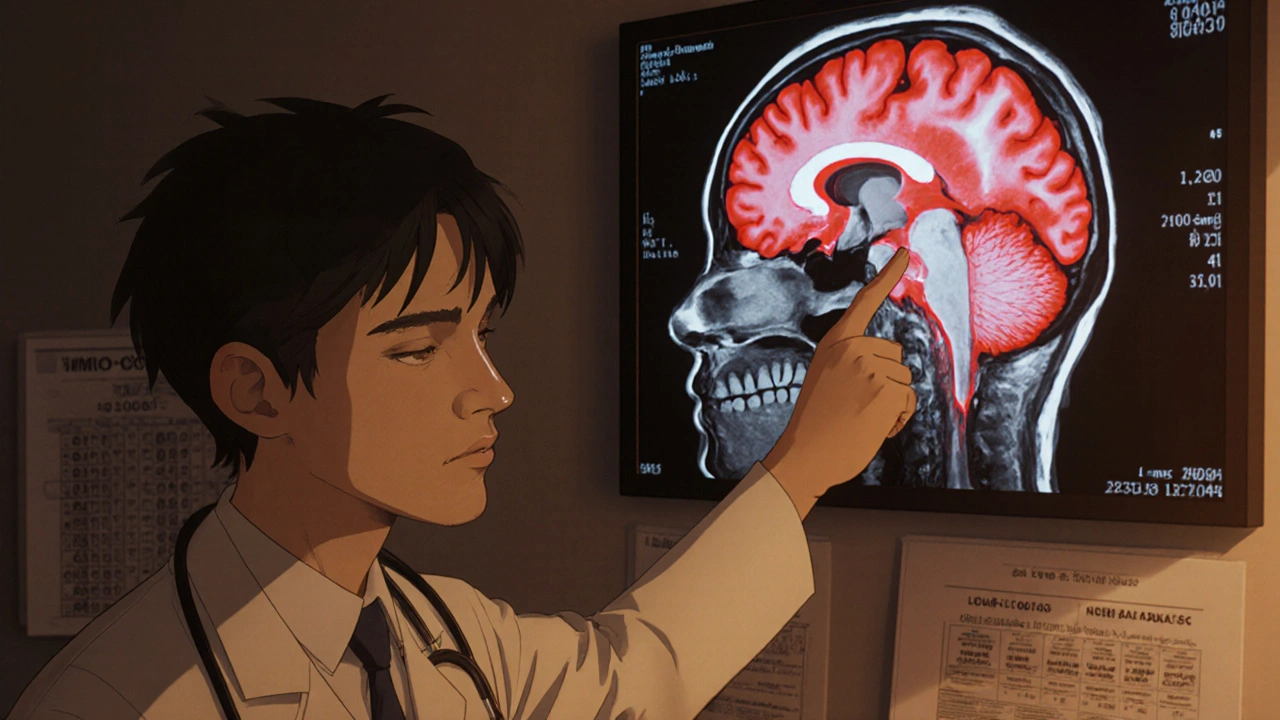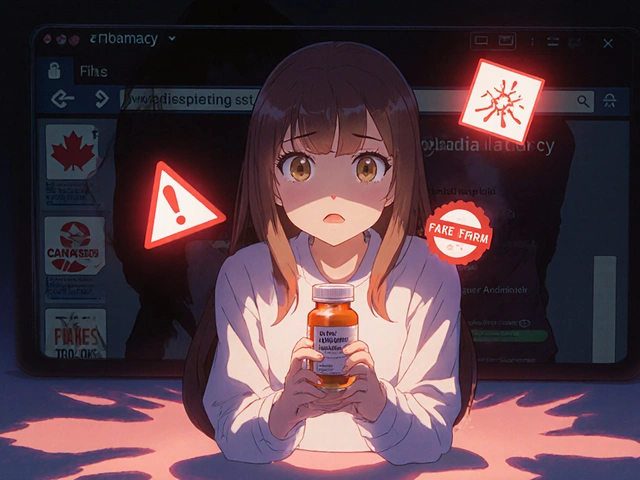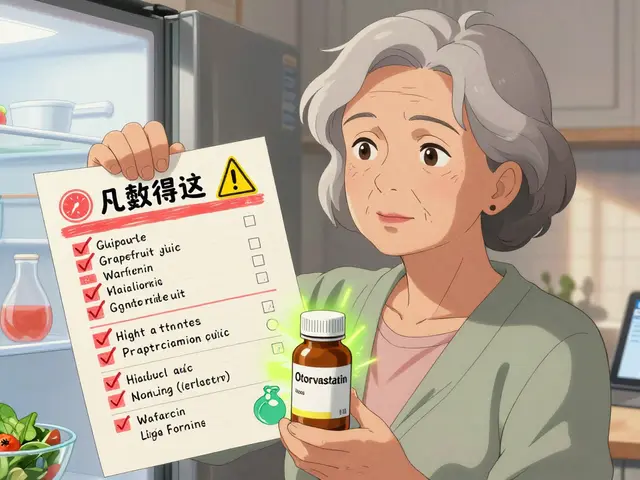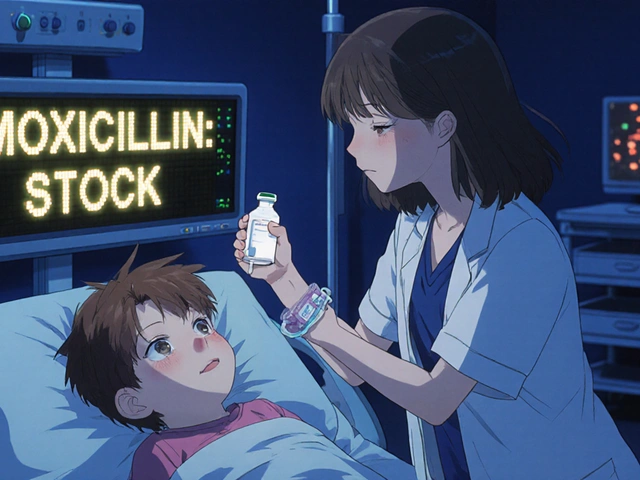PML Risk Calculator
Your Risk Assessment
No risk assessment available. Please select treatment options to proceed.
Most people carry the JC virus-about 50 to 70% of adults-and never know it. It’s quiet, harmless, and lives in the kidneys and brain tissue without causing trouble. But if your immune system gets knocked down-by cancer treatment, organ transplant drugs, or medications for multiple sclerosis-that virus can wake up. And when it does, it doesn’t just cause a cold. It can destroy the white matter of your brain, leading to a rare but deadly condition called Progressive Multifocal Leukoencephalopathy (PML).
What Exactly Is PML?
PML isn’t an infection you catch from someone else. It’s a reactivation of a virus already inside you. The JC virus, once harmless, starts attacking oligodendrocytes-the cells that make the protective myelin sheath around nerve fibers. When those cells die, your brain loses its ability to send signals properly. That’s when symptoms start: blurred vision, weakness on one side of the body, trouble speaking, loss of coordination, or even personality changes. These don’t come on suddenly like a stroke. They creep in over weeks or months, often mistaken for a relapse of multiple sclerosis or another neurological condition.Which Immunosuppressants Carry the Highest Risk?
Not all immunosuppressants are created equal when it comes to PML risk. Some are far more dangerous than others.- Natalizumab (Tysabri) is the biggest concern. Used for multiple sclerosis and Crohn’s disease, it blocks immune cells from entering the brain-which sounds good for reducing inflammation-but also stops them from spotting the JC virus. Among patients on natalizumab for more than two years, who are JC virus antibody-positive, and who’ve taken other immunosuppressants before, the risk jumps to 4.1 cases per 1,000 people. That’s about 1 in 250.
- Fingolimod (Gilenya) and Dimethyl fumarate (Tecfidera) carry lower but still real risks: 0.4 and 0.2 cases per 1,000 patient-years, respectively.
- Rituximab (Rituxan), often used for lymphoma and autoimmune diseases, has a PML rate of 0.8 per 1,000 patient-years.
- Drugs like interferon beta and glatiramer acetate? No confirmed PML cases ever reported.
What makes natalizumab especially tricky is what happens after you stop it. About half of PML patients develop something called immune reconstitution inflammatory syndrome (IRIS). That’s when your immune system, finally waking up, goes into overdrive and starts attacking the brain tissue damaged by the virus. It’s like your body’s defense system turning against itself-and it can be deadly.
How Do Doctors Measure Your Risk?
The main tool doctors use is the JC virus antibody test. It tells you if you’ve ever been exposed to the virus. But here’s the catch: it’s not perfect. About 2 to 3% of people who test negative still have the virus hiding in their body. That’s why some patients develop PML even when their test says they’re safe.There’s also something called the JC virus antibody index. It’s not just a yes/no result-it measures how strong your immune response to the virus is. If your index is above 1.5, your risk of PML after 48 months on natalizumab is nearly 11%. If it’s below 0.9, your risk is less than 0.1%. That’s a huge difference.
Doctors also look at your history. If you’ve taken drugs like azathioprine, methotrexate, or mitoxantrone before starting natalizumab, your risk goes up 2.5 times. That’s why the FDA now requires doctors to ask: “Have you ever taken another immunosuppressant?” before prescribing Tysabri.

What Do You Need to Watch For?
Symptoms of PML are subtle at first. You might notice:- Mild slurring of speech
- Blurred or double vision
- Weakness in one arm or leg
- Loss of balance or clumsiness
- Memory problems or confusion
These can easily be blamed on MS flare-ups, stress, or fatigue. But if you’re on a high-risk drug and you feel “off” in a new way-especially if it’s getting worse over days or weeks-you need to act fast. Early detection is everything. A brain MRI can spot PML lesions before symptoms get severe. That’s why experts recommend scans every 3 to 6 months for people on natalizumab or similar drugs.
Why Do Some People Miss the Warning Signs?
One of the biggest problems in PML diagnosis is misinterpretation. About 37% of early cases are mistaken for MS relapses. Neurologists need special training to tell the difference. PML lesions on an MRI look different from MS plaques-they’re irregular, asymmetrical, and don’t enhance with contrast dye. But not every clinic has radiologists who’ve seen enough PML cases to recognize them. That’s why academic medical centers are 22% more likely to have formal PML screening protocols than community practices.Another issue: lymphopenia. If your absolute lymphocyte count drops below 0.8 x 10⁹/L, your risk of PML jumps fourfold. Yet many doctors don’t routinely check this number. The American Academy of Neurology says current risk tools don’t account for it well-and that’s a gap.
What Are Patients Really Feeling?
On patient forums, fear of PML is constant. A survey of 214 people on natalizumab found 78% felt “extreme anxiety” about getting PML. Sixty-three percent said they’d stop the drug after two years-even if it was working well-just to reduce their risk.One Reddit user, u/MSWarrior2023, shared their story: “My JC virus test was negative. I had no symptoms. Then my MRI showed PML lesions. It was a shock.” That’s the 2-3% false negative rate in action.
But there’s hope. Another user, u/NatalizumabSurvivor, says they caught it early. “My neurologist stopped Tysabri right away. I went through IRIS treatment with steroids. Now I’ve regained 90% of my movement.” Early action saved their life.

What’s Being Done to Improve Safety?
The FDA requires doctors to complete two hours of training before prescribing natalizumab. Certification must be renewed every two years. That’s not just bureaucracy-it’s life-saving. Doctors need to know how to interpret antibody indexes, recognize early MRI signs, and understand when to stop treatment.Research is moving fast. A new therapy called DIAVIS T-cell therapy showed a 68% drop in death rates in a small 2024 trial. Immune checkpoint drugs like pembrolizumab are being tested to help the body fight the JC virus without triggering IRIS. The Cleveland Clinic is even running a trial to see if maraviroc, an HIV drug, can prevent PML in high-risk patients.
By 2030, experts predict PML risk from natalizumab could drop to just 0.5 cases per 1,000 patient-years-thanks to better screening, smarter monitoring, and new treatments. That could bring it back into the first-line treatment toolbox for certain patients.
What Should You Do If You’re on Immunosuppressants?
If you’re taking a drug linked to PML, here’s what you need to do:- Get tested for JC virus antibodies before starting-and repeat every 6 months.
- Ask your doctor for your antibody index value. Don’t just accept “positive” or “negative.”
- Know your history: Have you taken other immunosuppressants? If yes, your risk is higher.
- Get regular MRIs-every 3 to 6 months, especially after 24 months of treatment.
- Track your lymphocyte count. If it drops below 0.8, ask what it means for your risk.
- Report any new neurological symptoms immediately-even if they seem minor.
PML is rare. But when it happens, it’s devastating. The good news? You’re not powerless. With the right testing, monitoring, and communication with your doctor, you can manage this risk-and keep your treatment working for you.
Frequently Asked Questions
Can you get PML from a blood transfusion or contact with someone who has it?
No. PML is not contagious. It only happens when the JC virus, already in your body, reactivates due to a weakened immune system. You can’t catch it from another person.
If I test negative for JC virus, am I completely safe from PML?
No. About 2 to 3% of people who test negative still carry the virus. The test isn’t perfect. That’s why doctors also look at your treatment history, lymphocyte count, and MRI results-not just the antibody test.
What happens if I stop my immunosuppressant after PML is diagnosed?
Stopping the drug is the first step. But that can trigger IRIS-where your immune system attacks the damaged brain tissue. Doctors manage this with high-dose steroids or plasma exchange. Early intervention gives the best chance for recovery.
Are there alternatives to natalizumab if I’m worried about PML?
Yes. Drugs like ocrelizumab, dimethyl fumarate, and teriflunomide carry much lower PML risk. Many patients switch based on their personal risk tolerance. Your neurologist can compare your disease activity with your PML risk to find the best balance.
How often should I get an MRI if I’m on a high-risk drug?
Every 3 to 6 months is standard for high-risk patients, especially after 24 months of treatment. Some clinics start earlier if you have other risk factors like prior immunosuppressant use or low lymphocyte counts.







Write a comment
Your email address will be restricted to us